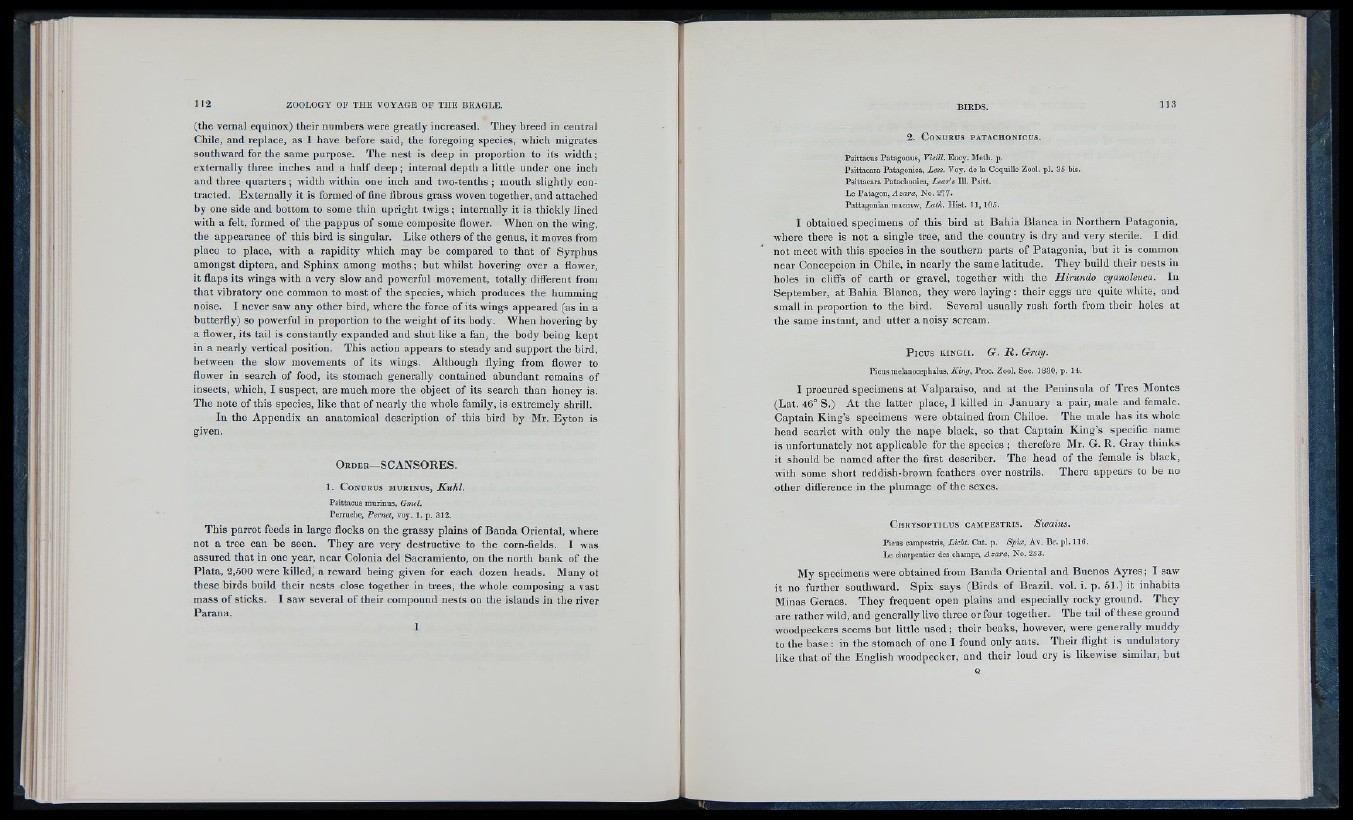
(the vernal equinox) their numbers were greatly increased. They breed in central
Chile, and replace, as I have before said, the foregoing species, which migrates
southward for the same purpose. The nest is deep in proportion to its width;
externally three inches and a half deep; internal depth a little under one inch
and three quarters; width within one inch and two-tenths ; mouth slightly contracted.
Externally it is formed of fine fibrous grass woven together, and attached
by one side and bottom to some thin upright twigs; internally it is thickly lined
with a felt, formed of the pappus of some composite flower. When on the wing,
the appearance of this bird is singular. Like others of the genus, it moves from
place to place, with a rapidity which may be compared to that of Syrphus
amongst diptera, and Sphinx among moths; but whilst hovering over a flower,
it flaps its wings with a very slow and powerful movement, totally different from
that vibratory one common to most of the species, which produces the humming
noise. I never saw any other bird, where the force of its wings appeared (as in a
butterfly) so powerful in proportion to the weight of its body. When hovering by
a flower, its tail is constantly expanded and shut like a fan, the body being kept
in a nearly vertical position. This action appears to steady and support the bird,
between the slow movements of its wings. Although flying from flower to
flower in search of food, its stomach generally contained abundant remains of
insects, which, I suspect, are much more the object of its search than honey is.
The note of this species, like that of nearly the whole family, is extremely shrill.
In the Appendix an anatomical description of this bird by Mr. Eyton is
given.
O r d e r — SCANSORES.
1 . C o n u r u s m u r i n u s , Kuhl.
Psittacus murinus, Gmel.
Pemiche, Pemet, yoy. 1. p. 312.
This parrot feeds in large flocks on the grassy plains of Banda Oriental, where
not a tree can be seen. They are very destructive to the corn-fields. I was
assured that in one year, near Colonia del Sacramiento, on the north bank of the
Plata, 2,500 were killed, a reward being given for each dozen heads. Many ot
these birds build their nests close together in trees, the whole composing a vast
mass of sticks. I saw several of their compound nests on the islands in the river
Parana.
1
2 . C o n u r u s p a t a c h o n ic u s .
Psittacus PatagODus, Vieill. Ency. Metli. p.
Psittacara Patagónica, Less. Voy. de la Coquille Zool. pl. 35 bis.
Psittacara Pataclionica, Lear's III. Psitt.
Le Patagón, Azara, No. 277-
Pattagonian maccaw, Lath. Hist. 11, 105.
I obtained specimens of this bird at Bahia Blanca in Northern Patagonia,
where there is not a single tree, and the country is dry and very sterile. I did
not meet with this species in the southern parts of Patagonia, but it is common
near Concepcion in Chile, in nearly the same latitude. They build their nests in
holes in cliffs of earth or gravel, together with the Hirundo cyanoleuca. In
September, at Bahia Blanca, they were layin g: their eggs are quite white, and
small in proportion to the bird. Several usually rush forth from their holes at
the same instant, and utter a noisy scream.
Picus K IN G I I . G. R .G r a y .
Picus mclanocephalus, Proc. Zool. Soc. 1830, p. 14.
I procured specimens at Valparaiso, and at the Peninsula of Tres Montes
(Lat. 46° S.) At the iatter place, I killed in January a pair, male and female.
Captain King’s specimens were obtained from Chiloe. The male has its whole
head scarlet with only the nape black, so that Captain King’s specific name
is unfortunately not applicable for the species ; therefore Mr. G. R. Gray thinks
it should be named after the first describer. The head of the female is black,
with some short reddish-brown feathers over nostrils. There appears to be no
other difference in the plumage of the sexes.
C h r y s o p t i l u s c a m p e s t r i s . Swains.
Picus campestris, Licht. Cat. p. Spix, Av. Br. pi. 116.
Le charpentier des champs, Azara, No. 253.
My specimens were obtained from Banda Oriental and Buenos Ayres; I saw
it no further southward. Spix says (Birds of Brazil, vol. i. p. 51.) it inhabits
Minas Geraes. They frequent open plains and especially rocky ground. They
are rather wild, and generally live three or four together. The tail of these ground
woodpeckers seems but little used; their beaks, however, were generally muddy
to the base : in the stomach of one I found only ants. Their flight is undulatory
like that of the English woodpecker, and their loud cry is likewise similar, but